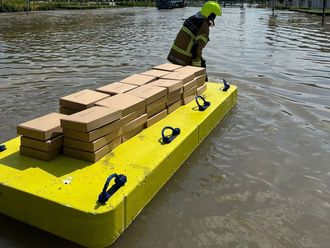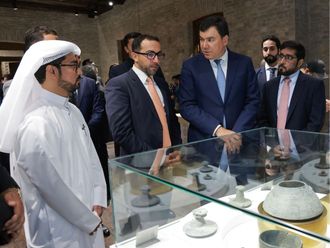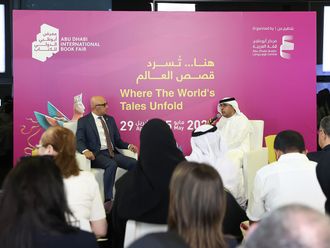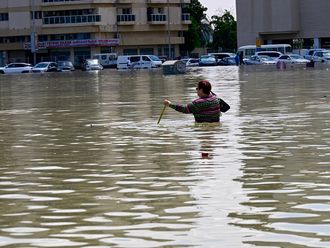A look at the system which claims to improve a child's memory and thought process
Iddin Faizal Bin HJ Mohamed Khair and Alan Wong show their skills using abacus during a UCMAS demonstration in Abu Dhabi. ©Gulf News |
Basically, the movement of the beads (see illustration on Page 2) towards the central beam on a particular rod forms a picture and simultaneously a mathematical value. This association of the value or amount with the image of the bead formation on the abacus is imprinted into the child's mind. "The key in learning the UCMAS lies in practising on the abacus," admits Wong.
Flash cards are used to enhance the visuals and help them memorise the pictures. By the end of the programme they have 450,000 images stored in their memory.
Once they perfect their ability to recall these images and convert them into numbers, they are ready to attempt sums mentally with the help of the abacus — and without it after some time. It's possible to learn addition, subtraction, multiplication, exponents, factors and percentage on the abacus, Wong claims.
There's one more skill which gets honed as they learn the UCMAS. Using both hands to rapidly work on the beads on the abacus helps children to improve their motor skills, says Wong.
Moreover, their skill of picking up the "visual" aspects and process them improves, while mental maths only perks up their concentration and hearing.
During the training of the UCMAS course instructors in Abu Dhabi, two children from Malaysia were given long complex sums to calculate. And, the children holding two-miniature abacus in their hands, moved the beads around rapidly, and in a flash gave the right answer.
How to participate
Children in the age group of four to 12 years are the target of the programme, which will be available to parents from centres in Abu Dhabi and Dubai — franchised by the UAE UCMAS corporate office in the La Marquise building on the Hamdan and Salam Street junction in Abu Dhabi.
The different centres will house classrooms where a maximum of 12 to 15 children will participate in each class.
Children have to undergo nearly eight levels before completing the programme, starting from basic to the grand level. This is done over a period of 30 months, which involves the child taking a two-hour class once a week, with each level lasting three months.
In addition, the child has to practise for 15 minutes every day for the rest of the six days of the week.
At the end of each level, the child has to pass an examination to qualify for the next level.
The cost of the programme works out to Dh250 a month, apart from a one-time registration fee of Dh250.
The registration fee entitles the child to an abacus, the programme books, t-shirt, a bag and information booklets.












